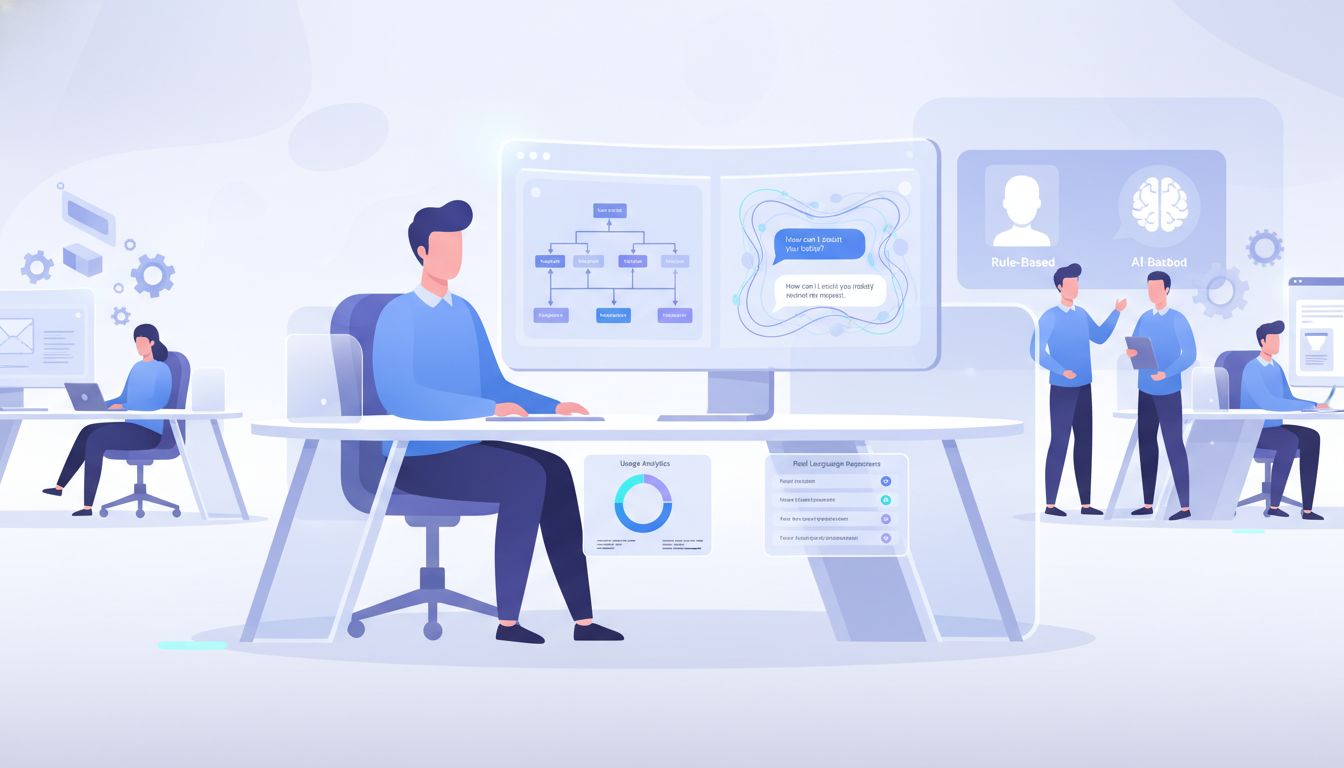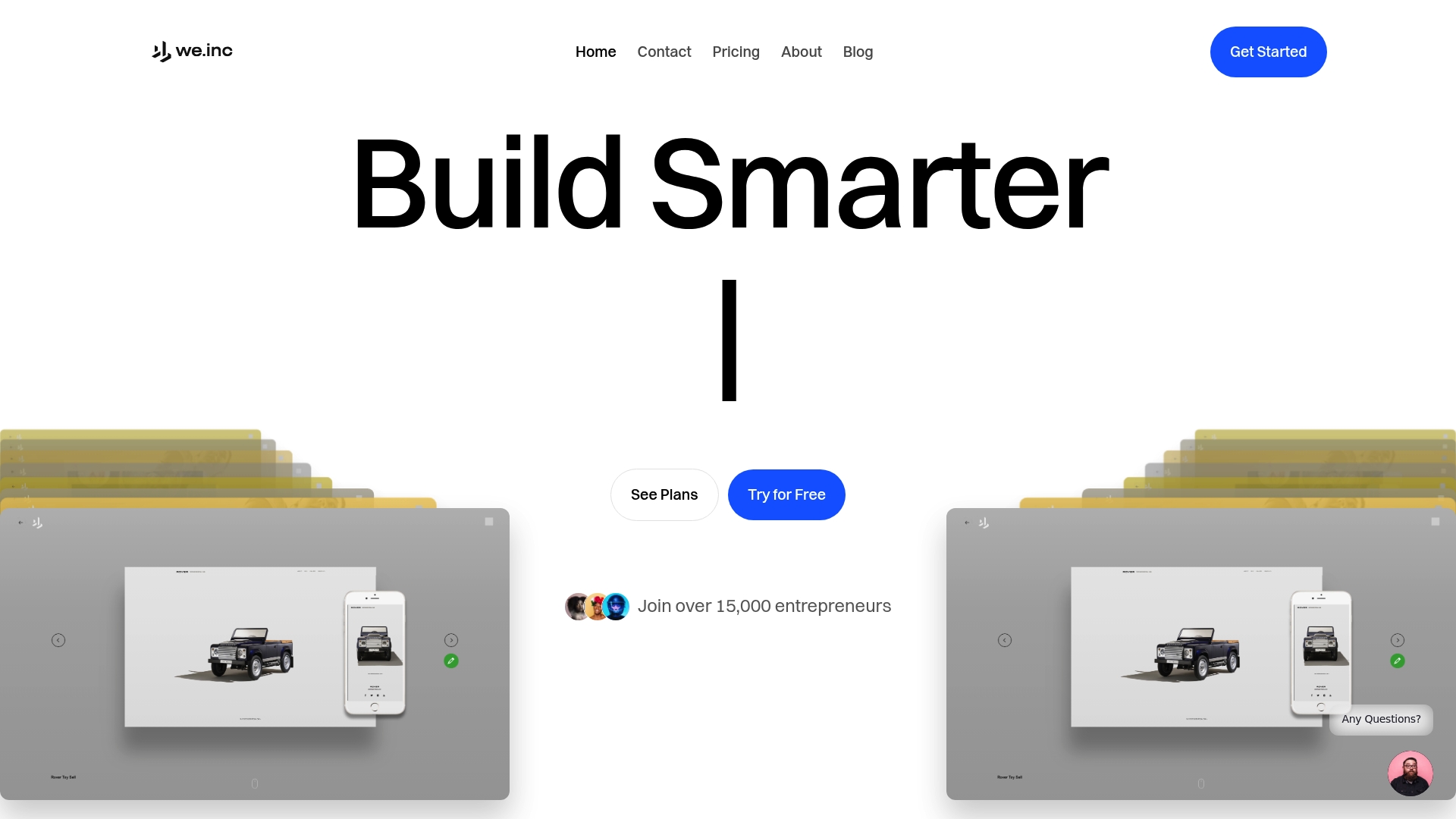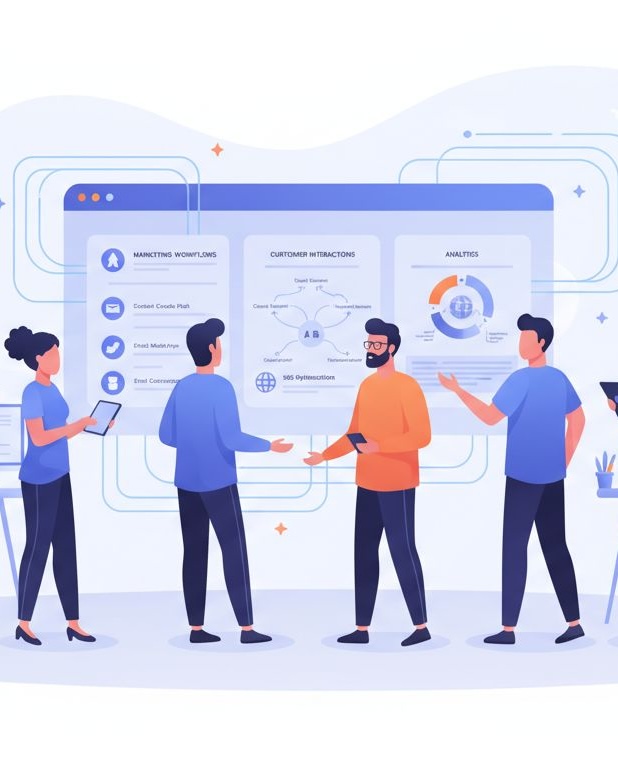Why Use AI Chatbots: Complete Guide for Businesses

Did you know that over 65 years after artificial intelligence was first studied, experts still debate what ‘intelligence’ even means? This confusion helps fuel many myths around AI chatbots and their role in modern business. Understanding the real strengths and limits of these tools can help you make smarter decisions about customer service, digital communication, and automation.
Table of Contents
- Defining AI Chatbots And Common Misconceptions
- Types Of AI Chatbots And Their Key Differences
- Core Features And How AI Chatbots Operate
- Popular Use Cases Across Business Functions
- Potential Challenges And Best Practices For Integration
- Comparing AI Chatbots To Alternative Solutions
Key Takeaways
| Point | Details |
|---|---|
| AI Chatbots Defined | AI chatbots utilize machine learning and natural language processing to simulate human conversation, moving beyond traditional scripted systems. |
| Types of Chatbots | Businesses can choose from various chatbot types—rule-based, AI-based, voice, and hybrid—each offering distinct capabilities. |
| Core Features | Key functionalities of AI chatbots include understanding user intent, generating relevant responses, and learning from interactions to enhance performance. |
| Integration Challenges | Successful integration of AI chatbots requires careful attention to data accuracy, bias mitigation, and user experience for effective communication. |
Defining AI Chatbots and Common Misconceptions
An AI chatbot represents a sophisticated software program utilizing artificial intelligence technologies to simulate human conversation through text or voice interactions. Unlike traditional scripted response systems, AI chatbots leverage machine learning and natural language processing to understand context, interpret user intent, and generate dynamic, contextually relevant responses.
Historically, AI systems have struggled with clear definitions, which contributes to widespread misconceptions. According to arXiv, artificial intelligence has been a field of study for over 65 years, yet terms like ‘intelligence’ remain formally undefined, leading to confusion about AI capabilities. This definitional ambiguity creates fertile ground for misunderstandings about what AI chatbots can truly accomplish.
One prevalent misconception stems from the ELIZA effect, a psychological phenomenon where humans attribute human-like understanding to computer programs. As Wikipedia explains, this cognitive bias leads users to overestimate AI chatbot capabilities, believing these systems comprehend conversations when they’re actually performing sophisticated pattern matching.
To demystify AI chatbots, consider their core functionalities:
- Interpret user messages using advanced natural language processing
- Generate contextually appropriate responses
- Learn and improve interactions through continuous machine learning
- Provide 24/7 automated customer engagement
- Handle multiple conversation threads simultaneously
Learn more about AI business tools to understand how these technologies can transform your operational efficiency.
Types of AI Chatbots and Their Key Differences
AI chatbots are not a one-size-fits-all solution. Businesses can leverage different types of chatbots depending on their specific communication and operational needs, each with unique capabilities and design approaches. According to Edu Zone Journal, chatbots can be fundamentally categorized into four primary types: rule-based, AI-based, voice, and hybrid systems.
Rule-based chatbots operate using predefined scripts and decision trees, responding to specific keywords and phrases with predetermined answers. In contrast, AI-based chatbots utilize advanced machine learning algorithms to interpret user intent, understand context, and generate more dynamic responses. According to JIER, these AI systems can be further classified into three sophisticated categories:
- Retrieval chatbots: Access and provide information from a predefined knowledge base
- Generative chatbots: Use machine learning to create human-like, contextually appropriate responses
- Transactional chatbots: Facilitate specific actions like booking appointments or processing payments
Voice chatbots represent another innovative category, integrating voice recognition technology to enable more natural, conversational interactions. Hybrid chatbots combine multiple approaches, blending rule-based precision with AI’s adaptive learning capabilities. This flexibility allows businesses to create more intelligent, responsive communication systems tailored to their unique requirements.

Here’s a comparison of the main AI chatbot types and their characteristics:
| Chatbot Type | Key Capabilities | Limitations |
|---|---|---|
| Rule-based | Follows preset scripts Deterministic answers |
Poor context handling |
| AI-based | Learns from data Generates dynamic replies |
Requires extensive training |
| Voice | Accepts spoken input Enables hands-free use |
Needs advanced voice tech |
| Hybrid | Combines rule-based and AI Flexible responses |
More complex setup |
Explore powerful business automation strategies to understand how different chatbot types can transform your customer engagement and operational efficiency.
Core Features and How AI Chatbots Operate
AI chatbots represent a sophisticated blend of technologies designed to simulate intelligent human conversation. According to arXiv, these intelligent conversational agents are activated by natural language input and generate responsive output, executing tasks with remarkable precision and adaptability.
The core operational mechanism of AI chatbots involves multiple advanced technologies working in synchronization. Natural language processing enables these systems to understand user intent, while machine learning algorithms continuously refine their response generation capabilities. As highlighted by Educational Technology Journal, modern AI chatbots are trained on extensive datasets of text and code, which empowers them to:
- Generate contextually relevant text
- Create diverse content types
- Provide informative and accurate answers
- Adapt to complex communication scenarios
- Learn from interaction patterns
Under the hood, AI chatbots employ sophisticated techniques like semantic analysis, intent recognition, and contextual understanding to interpret user messages. These systems don’t merely match keywords but comprehend the nuanced meaning behind communication, enabling more natural and intelligent interactions. The training data’s depth and quality significantly influence a chatbot’s ability to generate precise, helpful responses.
Explore essential AI tools for startups to understand how cutting-edge technologies can transform your business communication strategies.
Popular Use Cases Across Business Functions
AI chatbots have emerged as transformative tools across multiple business functions, revolutionizing how organizations interact with customers, manage internal processes, and deliver services. According to JIER, customer service represents one of the most prominent applications, where chatbots provide 24/7 availability and immediate response capabilities.
In customer service contexts, these intelligent systems dramatically reduce operational costs by automating repetitive interactions. They handle basic inquiries efficiently, freeing human agents to focus on more complex problem-solving scenarios. Beyond customer support, AI chatbots are making significant inroads into other critical business domains:
- Sales and Marketing: Qualifying leads and providing personalized product recommendations
- Human Resources: Screening job applications and answering employee policy questions
- Training and Development: Delivering interactive learning experiences
- Technical Support: Troubleshooting common technical issues
- Scheduling and Booking: Managing appointments and reservations
In educational settings, arXiv highlights how AI chatbots are transforming learning environments by assisting educators in content creation, offering personalized suggestions, and acting as interactive online learning companions. However, businesses must remain cognizant of potential limitations, such as the risk of generating occasional inaccurate information.
Explore essential AI tools for startups to discover how intelligent automation can revolutionize your business operations.
Potential Challenges and Best Practices for Integration
AI chatbot integration represents a complex technological endeavor fraught with potential pitfalls that businesses must carefully navigate. According to Live Science, large language models frequently oversimplify complex information, potentially creating significant risks in sensitive operational contexts.
Research reveals critical challenges that demand strategic management:
- Data Accuracy: Ensuring consistent, reliable information delivery
- Bias Mitigation: Preventing discriminatory or unfair responses
- Privacy Protection: Maintaining robust data security protocols
- Technical Compatibility: Seamlessly integrating with existing systems
- User Experience: Creating intuitive, helpful interaction interfaces
Moreover, AP News highlights a crucial concern from Stanford School of Medicine, indicating that AI systems can inadvertently perpetuate harmful biases. This underscores the importance of comprehensive bias detection and correction mechanisms during chatbot development and deployment. Businesses must implement rigorous testing, regularly audit response patterns, and maintain human oversight to ensure ethical and accurate AI interactions.
Explore essential AI tools for startups to develop robust, responsible AI communication strategies.
Comparing AI Chatbots to Alternative Solutions
AI chatbots have emerged as powerful communication tools, offering distinct advantages over traditional customer interaction methods. According to arXiv, these intelligent conversational agents are increasingly preferred due to their ability to provide immediate responses and automate complex tasks with remarkable efficiency.
When comparing AI chatbots to alternative solutions, several key differentiators become apparent:
- Traditional Call Centers: Higher operational costs, limited availability
- Email Support: Slower response times, less personalized interactions
- Static FAQ Pages: Limited interactivity and context understanding
- Manual Customer Service: Higher human resource requirements
- Scripted Chatbots: Less adaptive and contextually intelligent
However, businesses must recognize that AI chatbots are not without limitations. As Educational Technology Journal notes, platforms like ChatGPT and Google Bard, while powerful, may not always provide perfect accuracy. Their performance hinges critically on training data quality and the ability to stay current with evolving information landscapes.
 Intelligent implementation requires ongoing monitoring, periodic updates, and a nuanced understanding of their capabilities and constraints.
Intelligent implementation requires ongoing monitoring, periodic updates, and a nuanced understanding of their capabilities and constraints.
Explore our Unlimited Chatbots solution to discover how advanced AI can transform your customer engagement strategy.
Unlock the Power of AI Chatbots to Transform Your Business Today
The article highlights common challenges like overcoming limited automation, ensuring 24/7 customer engagement, and managing complex conversations with accuracy. If you are seeking solutions to reduce operational costs, improve response time, and scale effortlessly without technical headaches, leveraging AI-driven chatbot technology is the key. We.inc offers an all-in-one platform that empowers entrepreneurs and businesses to automate marketing and customer interactions quickly using intelligent, adaptable chatbots without coding.
Experience how AI chatbots can deliver dynamic, context-aware communication while integrating seamlessly with your website and social media efforts.

Start growing your online presence and driving sales now with We.inc. Unlock your business potential by creating high-converting websites, automating customer engagement with smart chatbots, and managing social media—all from a single dashboard. Visit our landing page to see how easy it is to get started and elevate your customer communication with advanced AI automation.
Frequently Asked Questions
What are AI chatbots and how do they work?
AI chatbots are advanced software programs that use artificial intelligence to simulate human conversations via text or voice. They utilize natural language processing and machine learning to understand context, interpret user intent, and generate dynamic responses.
What are the different types of AI chatbots available for businesses?
There are four primary types of AI chatbots: rule-based, AI-based, voice chatbots, and hybrid systems. Rule-based chatbots follow predefined scripts, while AI-based chatbots learn from interactions. Voice chatbots use voice recognition, and hybrid systems combine various approaches for enhanced flexibility and responsiveness.
What are the key features of AI chatbots?
Core features of AI chatbots include natural language processing for understanding user intent, machine learning for continuous improvement, 24/7 availability for customer engagement, and the ability to handle multiple conversation threads simultaneously.
How can businesses integrate AI chatbots into their operations?
Businesses can integrate AI chatbots by ensuring data accuracy, mitigating bias, protecting user privacy, and ensuring technical compatibility with existing systems. Regular testing and human oversight are essential for maintaining effective and ethical chatbot interactions.
%20(1).svg)

